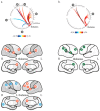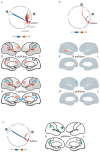Disrupted Pallido-Thalamo-Cortical Functional Connectivity in Chronic Disorders of Consciousness
- PMID: 33799582
- PMCID: PMC7999530
- DOI: 10.3390/brainsci11030356
Disrupted Pallido-Thalamo-Cortical Functional Connectivity in Chronic Disorders of Consciousness
Abstract
Chronic disorders of consciousness (DOC) encompass unresponsive wakefulness syndrome and minimally conscious state. Their anatomo-functional correlates are not clearly defined yet, although impairments of functional cortical networks have been reported, as well as the implication of the thalamus and deep brain structures. However, the pallidal functional connectivity with the thalamus and the cortical networks has not been studied so far. Using resting-state functional MRI, we conducted a functional connectivity study between the pallidum, the thalamus and the cortical networks in 13 patients with chronic DOC and 19 healthy subjects. We observed in chronic DOC patients that the thalami were no longer connected to the cortical networks, nor to the pallidums. Concerning the functional connectivity of pallidums, we reported an abolition of the negative correlation with the default mode network, and of the positive correlation with the salience network. The disrupted functional connectivity observed in chronic DOC patients between subcortical structures and cortical networks could be related to the mesocircuit model. A better understanding of the DOC underlying physiopathology could provide food for thought for future therapeutic proposals.
Keywords: cerebral networks; disorders of consciousness; functional resting-state connectivity; mesocircuit model; pallidum; thalamus.
Conflict of interest statement
The authors declare no conflict of interest.
Figures



References
-
- Royal College of Physicians . Prolonged Disorders of Consciousness Following Sudden Onset Brain Injury: National Clinical Guidelines. RCP; London, UK: 2020. [(accessed on 1 December 2020)]. Available online: https://www.rcplondon.ac.uk/guidelines-policy/prolonged-disorders-consci....
-
- Laureys S., Celesia G.G., Cohadon F., Lavrijsen J., León-Carrión J., Sannita W.G., Sazbon L., Schmutzhard E., Von Wild K.R., Zeman A., et al. Unresponsive wakefulness syndrome: A new name for the vegetative state or apallic syndrome. BMC Med. 2010;8:68. doi: 10.1186/1741-7015-8-68. - DOI - PMC - PubMed
-
- Vanhaudenhuyse A., Noirhomme Q., Tshibanda L.J.-F., Bruno M.-A., Boveroux P., Schnakers C., Soddu A., Perlbarg V., LeDoux D., Brichant J.-F., et al. Default network connectivity reflects the level of consciousness in non-communicative brain-damaged patients. Brain. 2009;133:161–171. doi: 10.1093/brain/awp313. - DOI - PMC - PubMed
Grants and funding
LinkOut - more resources
Full Text Sources
Other Literature Sources

